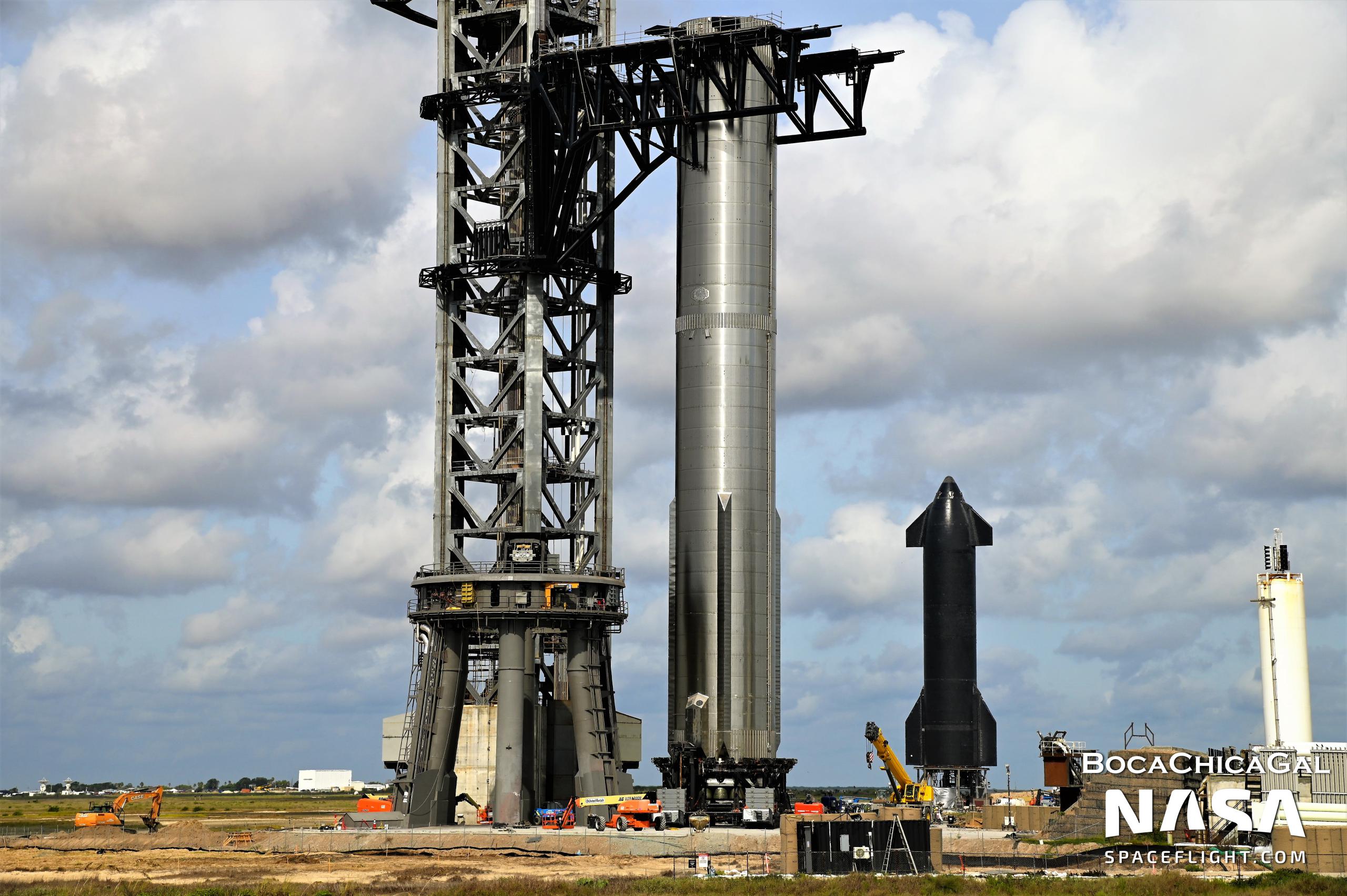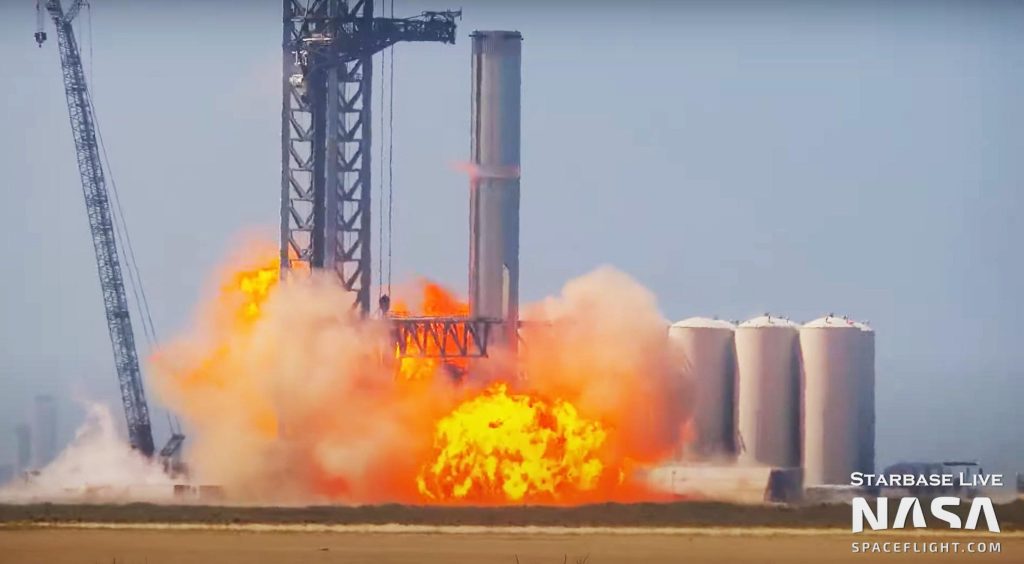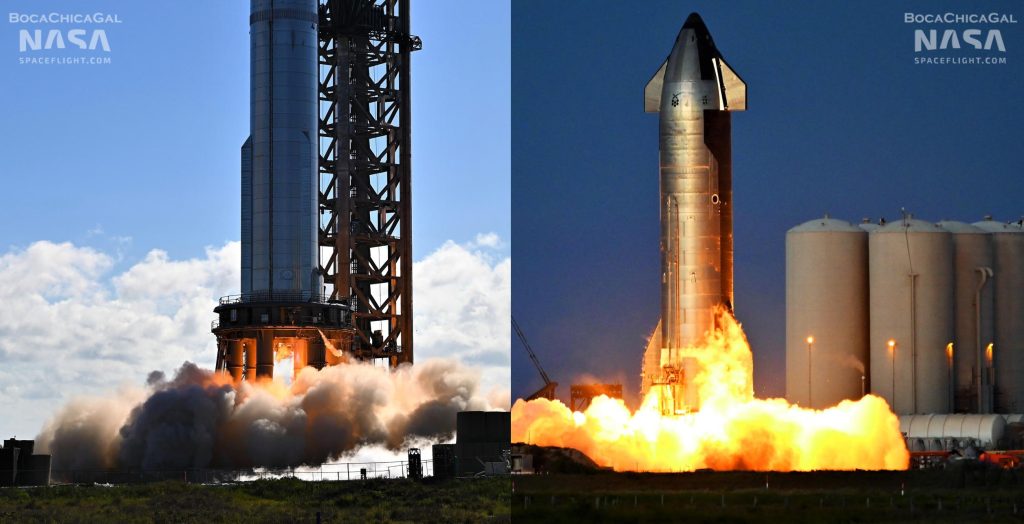

News
SpaceX Starship booster heads to launch pad for the fifth time
For the fifth time in five months, SpaceX has transported its most advanced Starship booster prototype from the Starbase factory to the launch pad, setting the stage for another round of testing.
Super Heavy Booster 7 (B7) returned to the factory for the fourth time on August 12th after becoming the first prototype of any kind to perform a static fire engine test while installed on SpaceX’s orbital Starship launch mount. In the days prior, the booster completed two back-to-back static fire tests with one of the 20 Raptor engines installed on the rocket, both of which apparently gave SpaceX enough confidence to prepare for the next phase of testing.
That relatively cautious progress only came after SpaceX attempted to test all 33 of the prototype’s Raptors at once during its first engine test. Whether it was the fault of overzealous managers or executives or a genuine oversight is not clear, but the combined behavior of Super Heavy and the orbital launch pad was not properly characterized before testing began. As a result, the cloud of flammable gas the rocket released during its attempted 33-engine ‘spin-prime’ test found an ignition source and violently exploded on July 11th, causing damage throughout Booster 7’s aft engine section that required several weeks of repairs between July 15th and August 6th.
When the Super Heavy rolled to the pad for the fourth time on August 6th, it was missing all 13 center Raptors, leaving only the outer ring of 20 Raptor Boost engines partially installed for the tests that followed. Thankfully, things went much better on the second try and Booster 7 completed two spin-prime tests with a single Raptor engine, followed by two successful static fire tests on August 9th and 11th. The latter test was the longest Starbase static fire ever (by a factor of ~3) and lasted about 20 seconds, allowing SpaceX to test Booster 7’s autogenous pressurization. That system pressurizes Super Heavy’s tanks by turning small quantities of cryogenic liquid propellant into gas, ensuring that its tanks remain stable as they’re rapidly drained of thousands of tons of propellant.
On August 12th, Booster 7 returned to the factory, where workers installed the rocket’s 13 center engines for the second time. Booster 7 headed back to the orbital launch site (OLS) on August 23rd and the pad’s robotic launch tower used a pair of arms to lift the rocket off its transport stand and place it on the launch mount by the end of the day.
In addition to readying Booster 7 for its next phase of static fire testing, teams of SpaceX workers took advantage of the unplanned lull in testing to modify the orbital launch mount. It’s impossible to know what exactly was done without official confirmation, but it’s likely that SpaceX was attempting to quickly fix the shortcoming(s) that allowed the July 11th explosion to happen. Without a fix, it’s unlikely that SpaceX would want to proceed with plans to ignite large numbers of Raptor engines simultaneously – a series of tests that must be completed before Starship can safely attempt its first orbital launch.


It’s unclear what exactly that fix entails, but it could involve a system to constantly flood the engine section with fire-stopping nitrogen gas or potentially take the shape of a system of vents that will connect to every Raptor engine and remove methane gas before it can turn into flammable clouds.
It’s possible that Booster 7 has returned to the launch pad solely for fit checks or some other basic proof-of-concept testing. It’s also possible that the returns signifies that SpaceX is confident in its quick launch mount fix and ready to restart static fire testing.
As Booster 7 prepares for that next phase of testing, SpaceX may also be ready to restart static fire testing with Starship S24, which paused shortly before Super Heavy returned to the factory. SpaceX appears to be modifying the suborbital launch mount and test stand Ship 24 is installed on, which could explain the lack of ship testing since August 11th. SpaceX has 12-hour test windows tentatively scheduled on August 24th and 25th, either of which could be used to test either or both prototypes.
If all goes to plan, Ship 24 and Booster 7 will eventually complete all the qualification testing SpaceX can throw at them and be ready to support Starship’s first orbital launch attempt sometime before the end of 2022.
News
Tesla Robotaxi has already surpassed Waymo in this key metric
Tesla Robotaxi has already overtaken Waymo in Austin in one key metric, but there’s still more work to do.

Tesla Robotaxi has already surpassed Waymo in one extremely important key metric: size of service area.
Tesla just expanded its service area in Austin on Monday morning, pushing the boundaries of its Robotaxi fleet in an interesting fashion with new capabilities to the north. Yes, we know what it looks like:
🚨 Tesla’s new Robotaxi geofence is…
Finish the sentence 🥸 pic.twitter.com/3bjhMqsRm5
— TESLARATI (@Teslarati) July 14, 2025
The expansion doubled Tesla Robotaxi’s potential travel locations, which now include the University of Texas at Austin, a school with over 53,000 students.
The doubling of the service area by Tesla has already made its travel area larger than Waymo’s, which launched driverless rides in October 2024. It became available to the public in March 2025.
According to Grok, the AI agent on X, Tesla Robotaxi’s current service area spans 42 square miles, which is five square miles larger than Waymo’s service area of 37 square miles.
Tesla Robotaxi (red) vs. Waymo geofence in Austin.
Much can be said about the shape… but the Robotaxi area is now ~3.9 mi² (10 km²) larger than Waymo’s!! pic.twitter.com/dVfh2ODxJC
— Robin (@xdNiBoR) July 14, 2025
The service area is one of the most important metrics in determining how much progress a self-driving ride-hailing service is making. Safety is the priority of any company operating a ride-hailing network, especially ones that are making it a point to use autonomy to deploy it.
However, these companies are essentially racing for a larger piece of the city or cities they are in. Waymo has expanded to several different regions around the United States, including Arizona and Los Angeles.
Tesla is attempting to do the same in the coming months as it has already filed paperwork in both California and Arizona to deploy its Robotaxi fleet in states across the U.S.
As the platform continues to show more prowess and accuracy in its operation, Tesla will begin to expand to new areas, eventually aiming for a global rollout of its self-driving service.
News
Tesla Megapacks arrive for massive battery replacing coal plant
Tesla Megapacks have started arriving on-site to the Stanwell Battery Project, just as Queensland prepares to wind down the Stanwell coal plant.

The first of over 300 Tesla Megapacks have arrived to the site of a massive battery energy storage system (BESS) being built in Australia, dubbed the Stanwell Battery Project after a coal plant it’s set to replace.
In a press release last week, the Stanwell Battery Project announced that the first Tesla Megapack 2XL units had arrived to the site, which is located outside of Rockhampton in Queensland, Australia. The project will eventually feature 324 Megapack units, set to arrive in the coming months, in order to support the 300MW/1,200MWh battery project.
“The Stanwell Battery is part of the diversification of our portfolio, to include cleaner and more flexible energy solutions,” said Angie Zahra, Stanwell Central Generation General Manager. “It is just one part of the 800 MW of battery energy storage capacity we have in our pipeline.
“Capable of discharging 300 MW of energy for up to four hours (1,200 MWh), our mega battery will be one of the largest in Queensland.”

Credit: Stanwell
Did you know Tesla’s Lathrop facility churns out a Megapack every 68 minutes? That’s enough energy to power 3,600 homes for an hour per unit! ⚡️ pic.twitter.com/bG6fpHkB9O
— TESLARATI (@Teslarati) June 11, 2025
READ MORE ON TESLA MEGAPACKS: Tesla Lathrop Megafactory celebrates massive Megapack battery milestone
The state is working with government-owned company Yurika to facilitate construction, and the process is expected to create roughly 80 jobs. The project is expected to come fully online in May 2027, with initial commissioning of the Megapacks aiming for November 2025.
The Stanwell Battery is set to replace the nearby Stanwell coal generation plant, which the government is planning to wind down starting in 2026 as part of efforts to reach an 80 percent renewable energy generation ratio by 2035. Meanwhile, the government is also set to begin winding down the Tarong and Callide coal plants, while several other Megapack projects are being built or coming online. o ya
Tesla currently has two Megapack production facilities, located in Lathrop, California, in the U.S. and another that came online earlier this year in Shanghai, China. The Shanghai Megafactory shipped its first units to Australia in March, while both factories are expected to be capable of producing 10,000 Megapack units per year upon reaching volume production.
News
The Tesla Diner is basically finished—here’s what it looks like
The company first broke ground on the Diner, Drive-in, and Supercharger location in September 2023. Now, it has served one of its first internal customers.

Tesla has finally completed the construction of its highly anticipated Diner, Drive-in, and Supercharger in Los Angeles, and recent photos of the interior’s “retro-futuristic” style are making their way around the internet.
X user Brad Goldberg shared photos from the Tesla Diner site last Tuesday, depicting some of the Supercharger stalls, indoor and outdoor seating areas, multiple neon lights, and even an Optimus robot. Goldberg also noted that there had been a “flurry of activity on site” while he was snapping the photos last week, suggesting that the restaurant location could be getting close to opening.
The Tesla Diner also served one of its first internal customers in the past few days, as Elon Musk posted on X on early Monday morning that he had just finished up eating a meal at the site:
I just had dinner at the retro-futuristic Tesla diner and Supercharger.
Team did great work making it one of the coolest spots in LA!
The photos also show that the site is pretty much done, with some of them even showing vehicles charging at the charging stalls.
You can see some of the latest photos of the Tesla Diner below.

Credit: BradGoldbergMD | X

Credit: BradGoldbergMD | X

Credit: BradGoldbergMD | X

Credit: BradGoldbergMD | X

Credit: TeslaKing420 | X

Credit: TeslaKing420 | X

Credit: Brad Goldberg (via Sawyer Merritt on X)

Credit: Brad Goldberg (via Sawyer Merritt on X)

Credit: Brad Goldberg (via Sawyer Merritt on X)

Credit: Brad Goldberg (via Sawyer Merritt on X)

Credit: Brad Goldberg (via Sawyer Merritt on X)
READ MORE ON TESLA’S LA DINER: Tesla readies Drive-In Diner Supercharger for launch with app inclusion
When will the Tesla Diner open to external customers?
While it’s still not open to external customers yet, the news again suggests that the company could be close to an official opening date. Tesla first broke ground on the Diner in September 2023, after receiving a wave of building permit approvals throughout that year. Teslarati also covered much of the construction progress throughout last year, including when crews installed the first and second drive-in screens.
Located at 7001 West Santa Monica Boulevard, the idea was first discussed in 2018 by Musk and a few others on Twitter, featuring 1950s rock and roll, waiters on roller skates, and drive-in movie theater screens playing clips from some of history’s best movies. Notably, the photos of the front doors also show that the site will be open 24 hours a day, 7 days a week, whenever it does end up opening.
Tesla’s progress on Supercharger with diner, drive-in seen in aerial footage
-

 Elon Musk2 weeks ago
Elon Musk2 weeks agoTesla investors will be shocked by Jim Cramer’s latest assessment
-

 News2 days ago
News2 days agoTesla debuts hands-free Grok AI with update 2025.26: What you need to know
-

 Elon Musk4 days ago
Elon Musk4 days agoxAI launches Grok 4 with new $300/month SuperGrok Heavy subscription
-

 Elon Musk7 days ago
Elon Musk7 days agoElon Musk confirms Grok 4 launch on July 9 with livestream event
-

 News1 week ago
News1 week agoTesla Model 3 ranks as the safest new car in Europe for 2025, per Euro NCAP tests
-

 Elon Musk2 weeks ago
Elon Musk2 weeks agoxAI’s Memphis data center receives air permit despite community criticism
-

 News4 days ago
News4 days agoTesla begins Robotaxi certification push in Arizona: report
-

 Elon Musk2 weeks ago
Elon Musk2 weeks agoTesla scrambles after Musk sidekick exit, CEO takes over sales

















